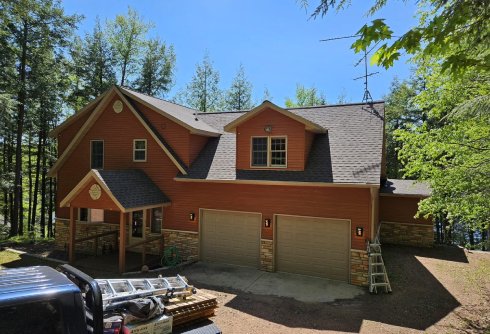Shingle roofing is one of the most common and widely used roofing systems for homes, appreciated for its versatility, affordability, and ease of installation. Shingle roofing involves the use of individual shingles made from various materials, such as asphalt, wood, slate, or synthetic materials, to cover the roof of a property. In this article, we will delve into the details of shingle roofing, including its advantages, types of shingles, installation methods, maintenance considerations, and its significant role in protecting and enhancing homes.
Shingle Roofing
- Home
- Services
Shingle Roofing

Advantages of Shingle Roofing:
1. Affordability: Shingle roofing is often more budget-friendly compared to other roofing materials like metal or slate. This makes it an attractive choice for homeowners looking for a cost-effective yet durable roofing solution.
2. Versatility: Shingles come in a wide range of materials, styles, and colors, allowing homeowners to choose a look that complements their home's architectural style and personal preferences.
3. Ease of Installation: Shingle roofing is relatively easy to install, which can help reduce labor costs and installation time. This makes it a practical choice for both new construction and roof replacement projects.
4. Repairability: In case of damage, individual shingles can be replaced without having to replace the entire roof. This makes shingle roofing cost-effective in terms of maintenance and repairs.
5. Weather Resistance: High-quality shingles are designed to withstand a variety of weather conditions, including rain, snow, hail, and wind. Some shingles even have impact resistance and can withstand severe storms.
Types of Shingles:
1. Asphalt Shingles: Asphalt shingles are the most common type of roofing material in North America. They are available in two main varieties: three-tab and architectural (also known as dimensional or laminate). Three-tab shingles are flatter and more affordable, while architectural shingles have a textured appearance and greater durability.
2. Wood Shingles and Shakes: Wood shingles and shakes provide a natural and rustic appearance. Cedar and redwood are popular choices due to their natural resistance to decay and insects. While they offer excellent aesthetics, wood roofing materials require more maintenance and are generally more expensive than asphalt shingles.
3. Slate Shingles: Slate shingles are known for their elegance and longevity. They are exceptionally durable, fire-resistant, and can last for over a century when properly maintained. However, slate roofing is heavy and can be costly to install.
4. Synthetic Shingles: Synthetic roofing materials, including composite shingles and rubber roofing, mimic the appearance of natural materials like wood or slate but offer increased durability and lower maintenance requirements.
Installation Methods:
Shingle roofing installation involves several key steps:
1. Roof Deck Preparation: The existing roof or roof deck is inspected for any damage or defects. Necessary repairs are made before roofing installation begins.
2. Underlayment Installation: An underlayment, typically made of felt or synthetic material, is installed over the roof deck to provide an additional layer of protection against moisture.
3. Shingle Installation: Shingles are applied in rows, starting from the eaves and working upward. Each shingle is secured with nails or adhesive, ensuring proper overlap and alignment for a watertight seal.
4. Flashing and Ventilation: Flashing is installed at roof transitions, such as valleys and roof penetrations, to prevent water infiltration. Proper ventilation systems are also installed to regulate attic temperature and prevent moisture buildup.
Maintenance and Care:
Maintaining a shingle roof is essential for its longevity and performance:
- Regularly inspect the roof for damaged or missing shingles, especially after severe weather events.
- Keep the roof clean by removing debris, leaves, and moss that can trap moisture and cause damage.
- Trim overhanging branches to prevent damage from falling limbs.
- Periodically check and clean the gutters to ensure proper drainage.
In conclusion, shingle roofing offers homeowners a versatile, cost-effective, and aesthetically pleasing roofing solution. With its various material options and styles, it can be tailored to match the architecture and design preferences of any home. Proper installation, maintenance, and repair ensure that a well-maintained shingle roof not only protects the home but also adds to its curb appeal and overall value. Whether it's the classic look of asphalt shingles, the timeless elegance of slate, or the natural charm of wood shingles, a carefully chosen and well-maintained shingle roof can provide security and comfort for years to come.
